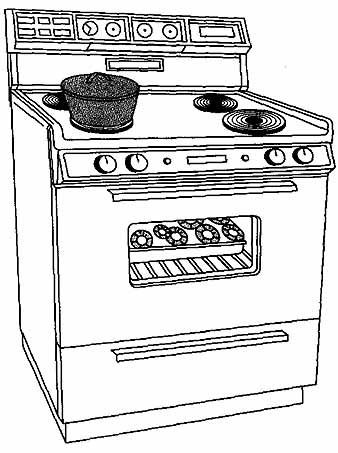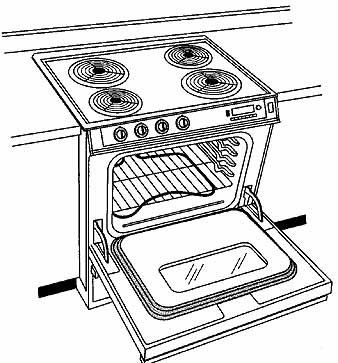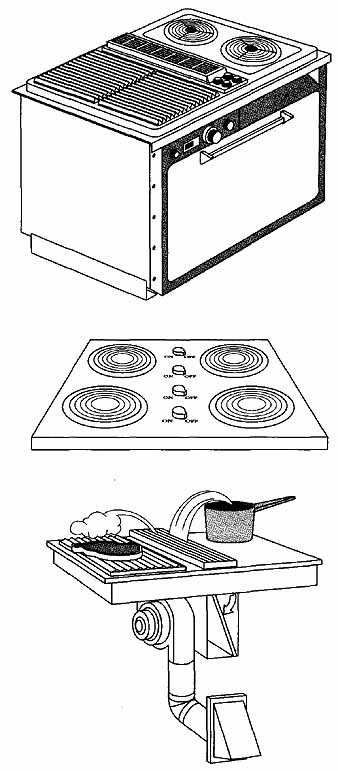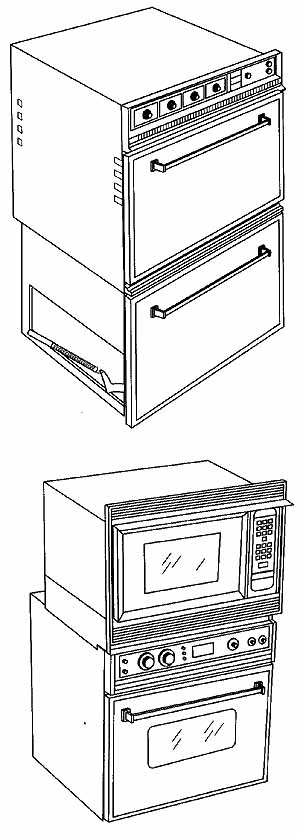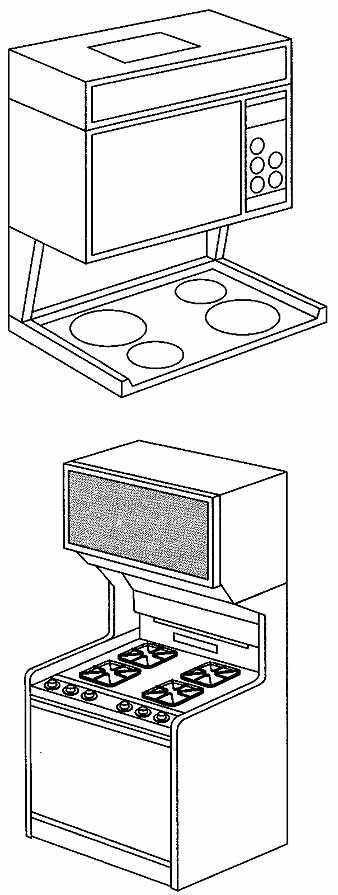Introduction; Ranges, cooktops, and ovens
| HOME | Troubleshooting | DIY Tips |
|
Introduction Both the technician and the consumer will appreciate this section because it addresses some of the problems of selection, acquisition, and installation of major home appliances. It’s also pertinent that technicians familiarize themselves with the features and functions of the appliances, which are stated in every new appliance’s use and care manual. This will be essential when diagnosing problems with the diverse types of appliances. This information will provide proper planning and a better understanding of major home appliances, including appliance warranties, and where to get help when it’s needed. In today’s market, major home appliances are manufactured to meet the needs of the average person. Remember that price should not be the most influential factor when choosing an appliance. Physical and mental limitations should also be considered when selecting the appliance that will be juxtaposed with the consumer’s needs. RANGES, COOKTOPS, AND OVENSThe domestic range was designed as a multi-purpose cooking appliance. It consists of a surface area, with heating elements on the top, to cook the food. The oven cavity is used for baking food at a set temperature. Within the same oven cavity, the broiling of food is also incorporated. Domestic ranges are available in a choice of electric or gas, in sizes ranging from 20 inches to 40 inches in width, and with a wide selection of configurations and colors. Freestanding ranges The freestanding range stands between two base cabinets, or sometimes at the end of a cabinet line. These ranges are available in 20-, 24-, 30-, 36-, and 40-inch widths ( Fig. __1). Some 40-inch models have two ovens. Designs include gas burners, standard electric heating elements, and a glass cooktop with concealed electric elements underneath. The controls might be located on the rear console, or across the front. Oven cleaning systems include self-cleaning, continuous-cleaning and standard- manual cleaning.
Listed below are some advantages and disadvantages of freestanding ranges ( Fig. __1): Advantages • Freestanding ranges are generally less expensive than other types. Prices vary with features. • Freestanding ranges can be moved when the family moves. • Most models have some center space for placing utensils. • Front controls can be reached easily from a seated position. • Bottom drawer adds to kitchen storage space. Disadvantages • Rear console controls are virtually impossible for a seated person. • Low broiler in gas ranges is less accessible, from a seated position, than the oven broiler in electric ranges. Slide-in ranges and drop-in ranges
Slide-in ranges and drop-in ranges might not always be available in all sizes: 30 inch is the most common ( Fig. __2). However, drop-in ranges are also available in a 27 inch width. Designs include gas burners, standard electric heating elements, and a glass cooktop with concealed electric elements underneath. The oven and cooktop controls are usually located across the front of the range. Some models have the cooktop controls along their side. They are an excellent choice for an island or peninsula shaped counter, because they are flush with the surrounding counter. These ranges can also be installed overlapping the adjacent countertop edges, eliminating dirt-catching gaps. A drop-in range either hangs from a countertop, or sits on a low cabinet base; and a slide-in range sits on the floor. Listed below are some advantages and disadvantages of slide-in ranges ( Fig. __2) and drop-in ranges ( Fig. __3): Advantages • Can be installed a few inches higher or lower than a freestanding range. • Controls can be reached by most cooks. Disadvantages • Built into kitchen and generally cannot be moved when the family relocates. • Requires installation by a carpenter and an electrician. Built-in cooktops Built-in cooktops are set into a countertop and are made in various sizes, from 15 to 48 inches wide. Built-in cooktop designs include gas burners, standard electric heating elements, and a glass cooktop with concealed electric elements underneath (Figs. __4 and __5). They might have side or front controls, and might be of modular design. Special plug-in cooking accessories are also available. Listed below are some advantages and disadvantages of built-in cooktops: Advantages • Can be installed at the most convenient height for the cook. • Side or front controls are easily reached by most cooks. • Counter installation provides open space below the cooktop. Disadvantages • Built into kitchen and generally cannot be moved when the family relocates. • Requires installation by a carpenter and an electrician.
Built-in ovens Built-in ovens usually have one oven cavity, but models with two oven cavities are also available. In the double oven cavity model, the second oven might be either a conventional, or a microwave, oven (Figs. __6 and __7). Built-in ovens are available in 24, 27, and 30 inch widths. They are designed to operate on either gas or electric. Their height varies, depending upon whether they are single or double oven units. Oven cleaning systems available include self-cleaning continuous-cleaning and standard manual-cleaning. Two-oven models also offer conventional ovens with two different cleaning systems. Built-in ovens, with the microwave feature, are avail able with either solid state microcomputer or electromechanical controls.
Listed below are some advantages and disadvantages of built-in ovens (Figs. __6 and __7): Advantages • Can be installed at the most convenient height for the user, putting controls within reach for both a standing or a seated cook. • Automatic cleaning systems virtually eliminate the task of cleaning the oven manually. Disadvantages • Built into the kitchen, and generally cannot be moved when the family moves. • Installation might involve structural and wiring changes, requiring a carpenter and an electrician. • Two-oven combinations with microwave ovens often require learning some new cooking techniques. Eye-level two-oven ranges Eye-level ranges are 30-inch-wide ranges which have a second oven mounted over the cooktop. The upper oven can be a conventional bake-and-broil oven, or a microwave oven. Designs include features like: • A selection of either gas burners or electric elements. • Choice between gas or electric oven. • Glass cooktop with concealed electric elements underneath. The lower ovens are available with self-cleaning or continuous-cleaning systems. Microwave oven combinations are available with solid-state microcomputer or electromechanical controls. This type of range gives the maximum cooking capacity in a minimum amount of floor space.
Advantages • Controls at eye level might be more convenient for cooks who use walkers, crutches, or a cane. • Automatic cleaning systems virtually eliminate the task of manually cleaning the oven. • Can be moved when the family relocates. Disadvantages • These controls, and also the oven cavity being located at eye level, are not usable by seated cooks.
|
